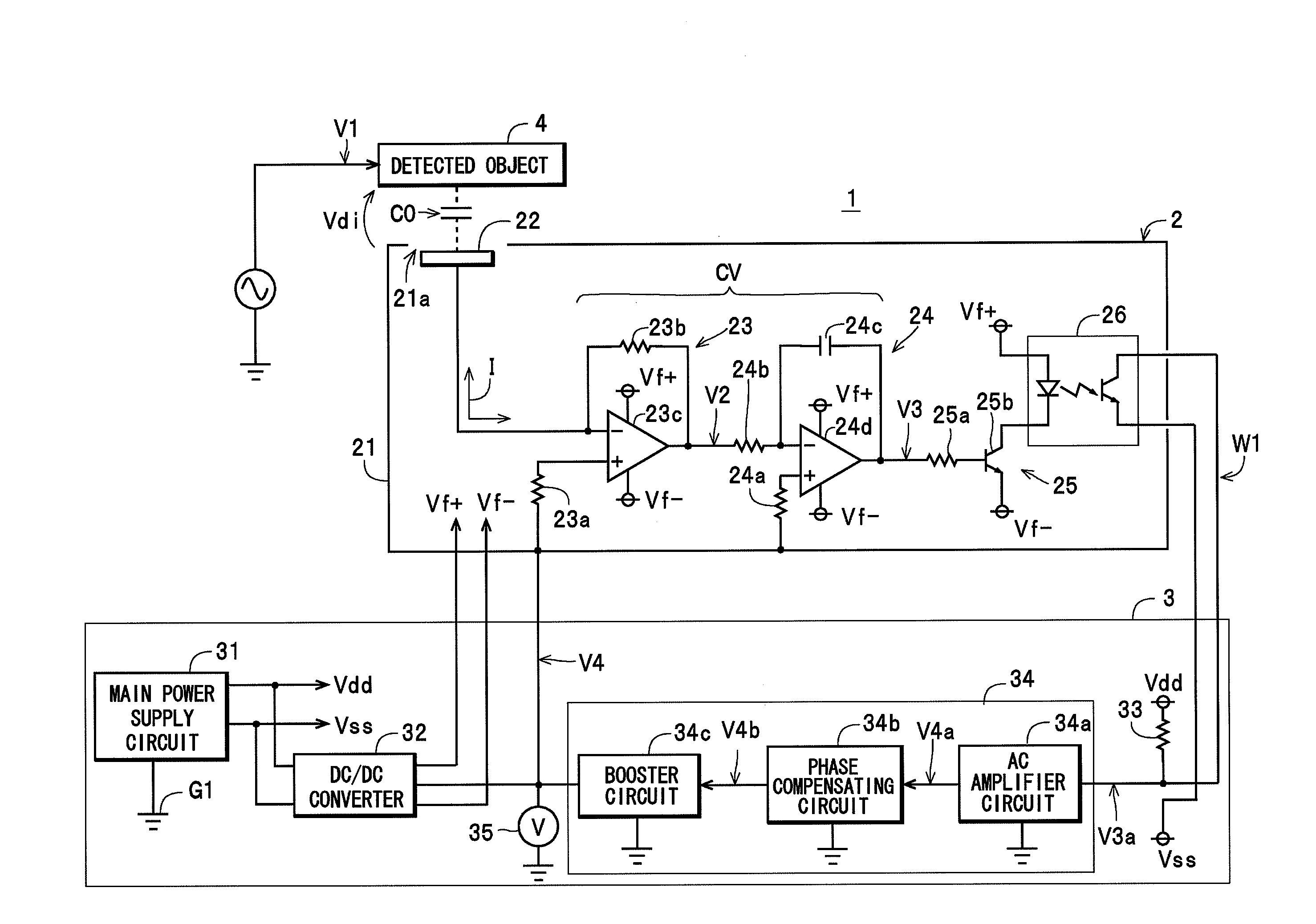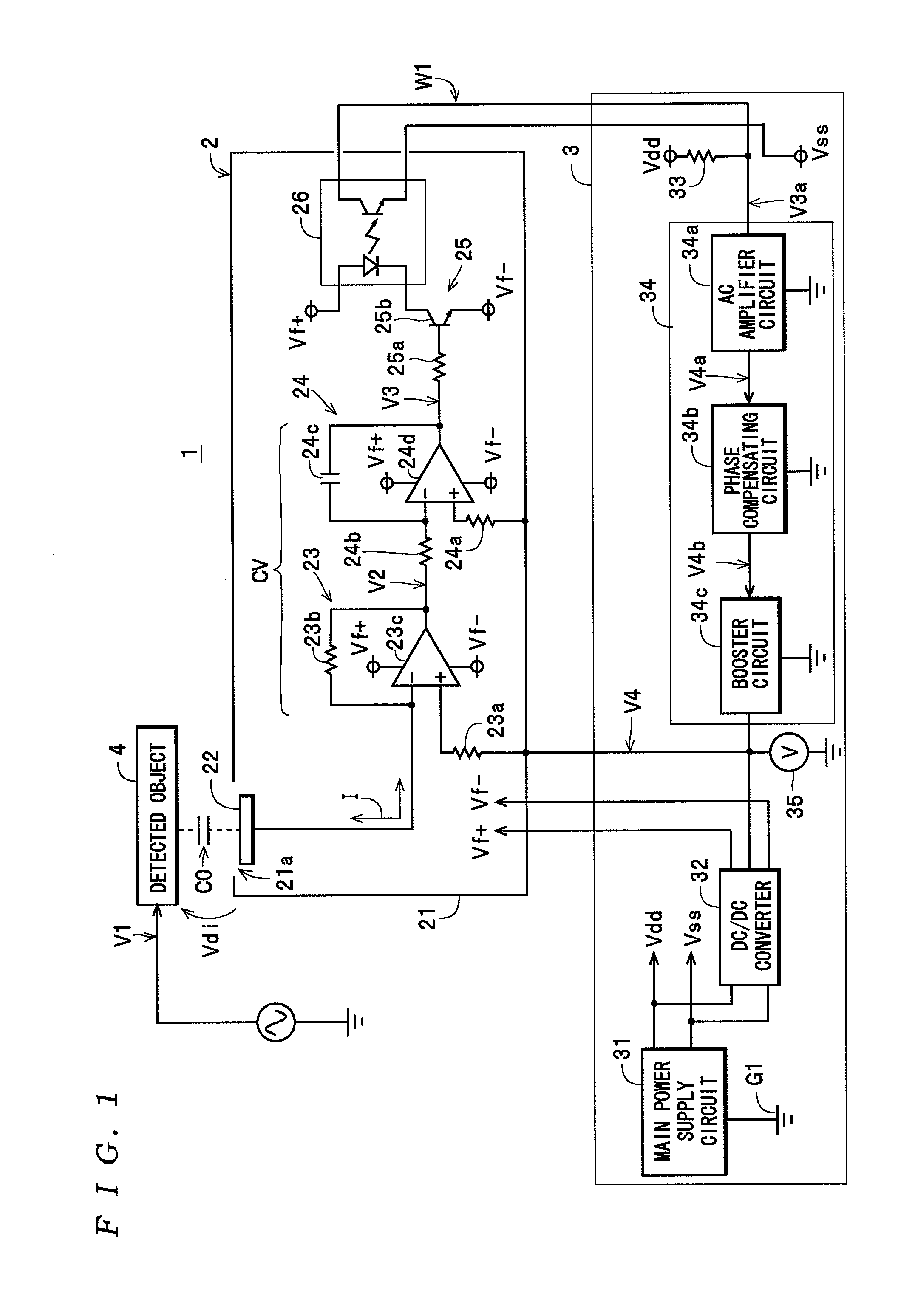Voltage detecting apparatus and line voltage detecting apparatus
a voltage detection and line voltage technology, applied in the direction of automatic balancing arrangements, instruments, ac/dc measuring bridges, etc., can solve the problems of increasing the cost of the apparatus, heavy load on the feedback circuit, and difficulty in following the voltage applied to the metal prong to follow the variations in the potential of the detected object, so as to reduce the apparatus cost and reduce the potential difference
- Summary
- Abstract
- Description
- Claims
- Application Information
AI Technical Summary
Benefits of technology
Problems solved by technology
Method used
Image
Examples
first embodiment
[0087]First, a voltage detecting apparatus (first voltage detecting apparatus) 1 according to the present embodiment will now be described with reference to the drawings.
[0088]The voltage detecting apparatus 1 is a non-contact voltage detecting apparatus, includes a floating circuit unit 2 and a main circuit unit 3 as shown in FIG. 1, and is constructed so as to be capable of detecting (measuring) an AC voltage V1 (detected AC voltage) generated in a detected object (measured object) 4 in a non-contact manner.
[0089]As shown in FIGS. 1 to 3, the floating circuit unit 2 includes a guard electrode 21, a detection electrode 22, a current-to-voltage converting unit CV, a driving circuit 25, and an insulating circuit 26. As one example in the present embodiment, the current-to-voltage converting unit CV includes a current-to-voltage converting circuit 23 and an integrating circuit 24. Also as one example in the present embodiment, the insulating circuit 26 is constructed of a photocoupler...
second embodiment
[0131]A second embodiment of a voltage detecting apparatus and a line voltage detecting apparatus will now be described with reference to the attached drawings.
[0132]First, a voltage detecting apparatus (second voltage detecting apparatus) 101 according to the present embodiment will be described with reference to the drawings. Note that components that are the same as in the voltage detecting apparatus 1 described above have been assigned the same reference numerals and description thereof is omitted.
[0133]The voltage detecting apparatus 101 is a non-contact voltage detecting apparatus, includes a floating circuit unit 2C and a main circuit unit 3 as shown in FIG. 10, and is constructed so as to be capable of detecting (measuring) an AC voltage V1 (detected AC voltage) generated in a detected object (measured object) 4 in a non-contact manner.
[0134]As shown in FIGS. 10, 11, a floating circuit unit 2C includes the guard electrode 21, the detection electrode 22, a bootstrap circuit 2...
third embodiment
[0159]A third embodiment of a voltage detecting apparatus and a line voltage detecting apparatus will now be described with reference to the attached drawings.
[0160]First, a voltage detecting apparatus (third voltage detecting apparatus) 201 according to the present embodiment will be described with reference to the drawings. Note that components that are the same as in the voltage detecting apparatuses 1, 101 described above have been assigned the same reference numerals and description thereof is omitted.
[0161]The voltage detecting apparatus 201 is a non-contact voltage detecting apparatus and as shown in FIG. 13 includes a floating circuit unit 2D and a main circuit unit 3C. The voltage detecting apparatus 201 is constructed so as to be capable of detecting the AC voltage V1 (detected AC voltage) generated in the detected object 4 using ground potential Vg as a reference.
[0162]As shown in FIG. 13, the floating circuit unit 2D includes a guard electrode 211, a detection electrode ...
PUM
 Login to View More
Login to View More Abstract
Description
Claims
Application Information
 Login to View More
Login to View More - R&D
- Intellectual Property
- Life Sciences
- Materials
- Tech Scout
- Unparalleled Data Quality
- Higher Quality Content
- 60% Fewer Hallucinations
Browse by: Latest US Patents, China's latest patents, Technical Efficacy Thesaurus, Application Domain, Technology Topic, Popular Technical Reports.
© 2025 PatSnap. All rights reserved.Legal|Privacy policy|Modern Slavery Act Transparency Statement|Sitemap|About US| Contact US: help@patsnap.com



